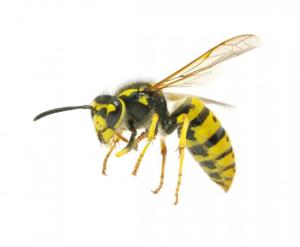Identifying wasps
Wasps:
- have black and bright yellow bands
- have a narrow waist in the middle of a thin body
- are 10-15mm long
- have a smooth, hairless body
- are often found around rubbish and food
- feed on other insects
- tend to fly in and out of a building, under the eaves for example, at quite high speed. (Honey bees tend to hover around at the entrance to the hive)
Bees are rounder, fatter, slower moving and hairier than wasps. The rear legs are fat, and they have duller coloration. They only feed on pollen, so they are often found near flowers and plants.
Please make sure that the insects are wasps and not bees. The law does not allow us to treat for bees and you will be charged the cost of the visit. We will not issue refunds in these circumstances.

Home treatments for wasps
An adult must be present throughout each visit. Treatments in your home involve:
- one visit
- injecting dust into the nest usually in lofts or outside under the eaves
- access from outside using a dust stick within 5 meters of the ground
- an advice sheet with information about the insecticide used, where it was placed and any special precautions
- taking measures to protect children and pets
The nest will be dead in one or two days after the treatment.
Useful facts
There is no need to remove a dead or dormant nest as wasps will not return to a dead/dormant nest. Wasps never return to last year's nest.
During the bee season in May and June, you should take particular care to ensure that you correctly identify whether you have bees or wasps.
Almost all nests discovered in early spring (March and early April) are dormant nests from a previous summer. You can often avoid unnecessary expense in early spring by only booking a service if you see wasps using the nest. If not it is almost certainly a dormant nest from a previous year.
Make a booking
If you book a wasp treatment, and our pest controller discovers that you have bees, the law does not allow us to undertake a treatment and you will be charged the cost of the visit.
We don’t issue refunds if we visit and find we are unable to treat the problem for any reason.
For queries about bookings and for payments:
- call 020 8753 1081
- email pestcontrol@lbhf.gov.uk
How much does it cost?
£82.60 (1 visit).
For commercial rates and information see landlords, commercial premises, restaurants and schools.